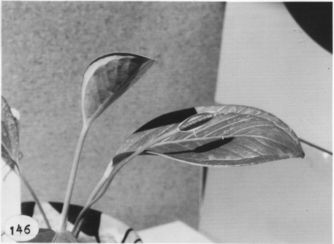




Anthurium supraglandulum Croat, sp. nov.
TYPE: Panama. Panama: Cerro Jefe, at summit, ca. 1,000 m, 15 mi. from Pan-American Hwy., Croat 49087 (MO 2737333, holotype; PMA, isotype; Live at MO).
Plantaepiphytica; cataphyllum membranaceum persistens in fibris tenuibus; petiolus subteres, complanatus aut sulcatus adaxiale, suleo cum costa media; lamina oblongo-elliptica, raro oblanceolato-elliptica aut ovata, basi acuta, 6-19 cm longa, 2.3-8.5 cm lata, utrinque dense glanduloso-punctata; inflorescentia foliis longiora; pedunculus 10-35 cm longus; spatha membranacea, viridulo-alba, oblongo-elliptica, 1.3-3.5 cm longa (raro 8 cm longa), 8-16 mm lala; spadix pier-unique sessilis, violaceus purpureus, 2-12(-17) cm longus; baccae ignotae.
Epiphyte; stems less than 15 cm long, ca. 8 mm diam.; leaf scars ca. 5 mm diam., inconspicuous; cataphylls thin, 1.5-3 cm long, rounded at apex with subapical apiculum, drying reddish brown, weathering to fine persistent fibers.
LEAVES erect; petioles 2-29 cm long, 2.5-5 mm diam., subterete, flattened to sulcate adaxially with a faint medial rib, the margins erect; geniculum ca. 1 cm long; blades oblong-elliptic, rarely oblanceolate-elliptic or ovate, bluntly acuminate at apex, rarely acuminate or rounded (the acumen apiculate, downtumed), acute at base, 6-19 cm long, 2.3-8.5 cm wide, usually broadest at the middle or above; upper surface semiglossy, densely glandular-punctate (the glands sunken), the epidermal cells convex, lower surface only slightly paler and less densely dark glandular-punctate; midrib prominently convexly raised above, diminished and sunken near apex, convexly raised below; primary lateral veins (3-)5-6 per side, departing midrib at 30-45° angle, straight to collective vein, weakly etched into surface above, prominulous below; interprimary veins drying equally as prominent as primary lateral veins; collective vein arising from the base, 2-8 mm from margin, weakly sunken above, prominulous below, a secondary collective vein sometimes joining margin in lower third of blade.
INFLORESCENCE usually longer than leaves; peduncle 10-35 cm long, 1-3 mm diam., (1.5-)3-6 times longer than petioles; spathe thin, greenish white, oblong-elliptic, more or less boat-shaped, 1.3-3.5 cm long (rarely to 8 cm long), 8-16 mm wide, broadest in the lower third, rounded and apiculate at apex, the margins acute or overlapping at base, decurrent on peduncle, inserted at ca. 45° angle on peduncle; spadix sessile or rarely with stipe to 3 mm long, violet purple (B & K Red-purple 3/10), scarcely tapered toward apex, 2-12(-17) cm long, 3-6 mm diam. midway, 2-4 mm diam. near apex; flowers square to rhombic, 1.7-3.4(-4.2) mm long, 1.3-2.8 mm wide, the sides straight to weakly sigmoid, 3-4 flowers visible in the principal spiral, 5-6 visible in the alternate spiral; tepals matte, minutely papillate, lateral tepals 0.6-1.1 mm wide, the inner margins broadly rounded; pistils not emergent, pinkish white; stamens probably emerging in a regular manner, promptly retracting beneath tepals after anthesis; anthers white, 0.4 mm long, 0.6 mm wide, held briefly above the tepals; thecae ovoid, slightly divaricate; pollen white.
INFRUCTESCENCE not known. Fig. 146.
Anthurium supraglandulum is endemic to central Panama and appears to be restricted to the region of Cerro Jefe at 600 to 1,000 m in tropical wet and premontane rain forest.
The species, a member of section Porphyrochitonium, is characterized by its epiphytic habit and small size, its short stem with persistent weathered cataphylls, and by its petioles that are generally shorter than the blades. It is also distinguished by its elliptic or oblong-elliptic to oblanceolate-elliptic, acute to bluntly acuminate blades that are conspicuously glandular punctate on the upper surface and usually have a single pair of collective veins, but is most distinguished by its purple spadix and a peduncle that equals or usually greatly exceeds the length of the petioles.
Anthurium supraglandulum is most easily confused with A. bicollectivum and especially A. jefense, both of which have been collected in the Cerro Jefe region. Anthurium bicollectivum differs by its generally larger leaves, usually with prominent secondary collective veins and especially by its green rather than purple spadix.
Anthurium jefense shares with A. supraglandulum a dark violet purple spadix but differs in having lanceolate-elliptic to oblong-elliptic blades that are more prominently acuminate and lack the glands on the upper surface typical of A. supraglandulum. Anthurium jefense has white berries, but the berries of A. supraglandulum are still unknown.
Folsom et al. I860 differs from all other specimens of Anthurium supraglandulum m having small ovate leaf blades that are broadly rounded at the base. Nevertheless, it has the same leaf texture and type of inflorescence.

Panama: Cerro Jefe, António 4721. 4740 (MO), Croat 49087 (MO, PMA), Folsom et al. 1859, 1860 (MO), Folsom 2530 (MO), Folsom & Mauseth 7793B (MO), Hammel 3728 (MO), Kennedy 1167 (DUKE), Mori & Kallunki 2393 (MO), Mori et al. 3752 (MO, PMA, WIS), Mori 7983 (MO), Sytsma 1479, 1515 (MO), Tyson et al. 4384 (SCZ), Witherspoon 8533 (MO); La Eneida, Correa 820 (MO).